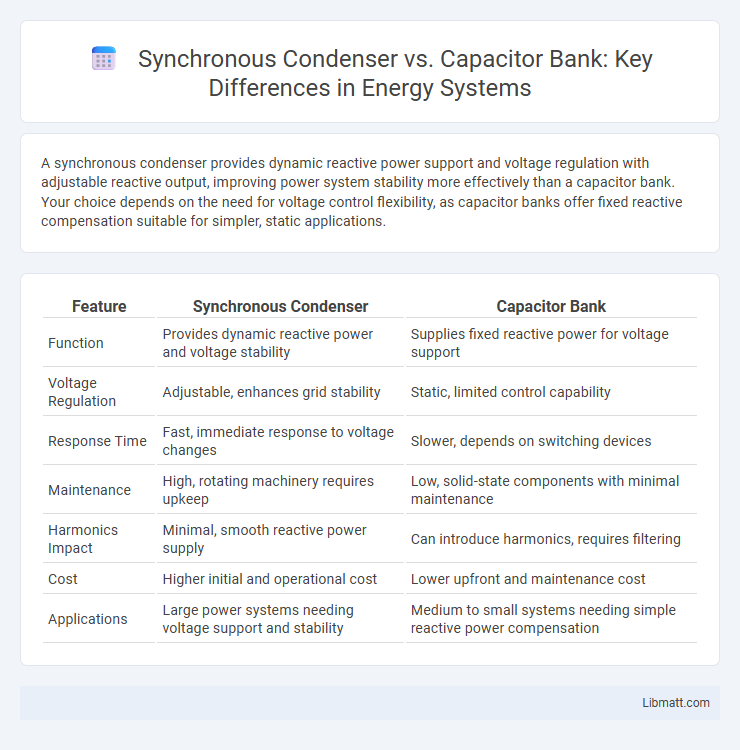A synchronous condenser provides dynamic reactive power support and voltage regulation with adjustable reactive output, improving power system stability more effectively than a capacitor bank. Your choice depends on the need for voltage control flexibility, as capacitor banks offer fixed reactive compensation suitable for simpler, static applications.
Table of Comparison
| Feature | Synchronous Condenser | Capacitor Bank |
|---|---|---|
| Function | Provides dynamic reactive power and voltage stability | Supplies fixed reactive power for voltage support |
| Voltage Regulation | Adjustable, enhances grid stability | Static, limited control capability |
| Response Time | Fast, immediate response to voltage changes | Slower, depends on switching devices |
| Maintenance | High, rotating machinery requires upkeep | Low, solid-state components with minimal maintenance |
| Harmonics Impact | Minimal, smooth reactive power supply | Can introduce harmonics, requires filtering |
| Cost | Higher initial and operational cost | Lower upfront and maintenance cost |
| Applications | Large power systems needing voltage support and stability | Medium to small systems needing simple reactive power compensation |
Introduction to Synchronous Condenser and Capacitor Bank
Synchronous condensers are rotating machines used in power systems to provide reactive power support and improve voltage stability by adjusting their excitation. Capacitor banks consist of fixed or switched capacitors that supply reactive power to the grid, primarily improving power factor and reducing transmission losses. Both devices play crucial roles in managing reactive power but differ significantly in operation, control capability, and dynamic response.
Working Principle of Synchronous Condenser
A synchronous condenser operates by adjusting its rotor excitation to either absorb or generate reactive power, stabilizing voltage and improving power factor in electrical grids. Unlike capacitor banks that provide fixed reactive power based on their capacitance, synchronous condensers offer dynamic control through synchronous motor principles, responding to changing load conditions. Your power system benefits from enhanced reliability and flexibility by using synchronous condensers for voltage regulation and reactive power compensation.
Working Principle of Capacitor Bank
A capacitor bank operates by storing electrical energy in electric fields through multiple capacitors connected in parallel, providing reactive power compensation to improve power factor and voltage stability in electrical systems. Unlike synchronous condensers that use rotating machines to generate reactive power, capacitor banks deliver reactive power instantly without moving parts, enhancing system efficiency and reducing operational costs. Your choice between these devices depends on the required response time, system size, and maintenance considerations.
Key Differences Between Synchronous Condenser and Capacitor Bank
Synchronous condensers provide dynamic reactive power support with adjustable output, enhancing voltage stability and system reliability, while capacitor banks offer fixed reactive power injection mainly for voltage support and power factor correction. Unlike capacitor banks, synchronous condensers can supply or absorb reactive power based on system demand, improving grid resilience under fluctuating loads. Your choice depends on the need for flexibility and precise voltage control versus cost-effective, static reactive power compensation.
Applications of Synchronous Condensers
Synchronous condensers are primarily used in power systems for voltage regulation, reactive power compensation, and improving system stability, especially in large-scale electrical grids integrating renewable energy sources. Unlike capacitor banks, synchronous condensers provide dynamic reactive power support, allowing real-time adjustment to changing load conditions and fault situations. They are essential in applications requiring voltage control during transient events, such as in industrial plants, utility substations, and wind or solar farms.
Applications of Capacitor Banks
Capacitor banks are widely used in power systems to improve power factor correction, voltage stabilization, and reactive power compensation. They are essential in industrial plants, commercial buildings, and utility substations to reduce energy losses and enhance equipment lifespan by minimizing the phase difference between voltage and current. Capacitor banks also help in load balancing and voltage support during peak demand periods, making them critical for maintaining efficient and stable electrical distribution networks.
Advantages of Synchronous Condensers
Synchronous condensers provide superior voltage regulation and reactive power control compared to capacitor banks, enhancing system stability and power quality in electrical grids. Their ability to deliver adjustable reactive power and inertia support helps prevent voltage fluctuations and improves transient stability during load variations. Unlike fixed capacitor banks, synchronous condensers can dynamically respond to changing system conditions, reducing the risk of overvoltage and supporting grid resilience.
Advantages of Capacitor Banks
Capacitor banks offer efficient reactive power compensation, improving voltage stability and reducing power losses in electrical systems. They are cost-effective, require minimal maintenance, and provide quick response times to changing load conditions. Your power network benefits from enhanced power factor correction and energy savings when integrating capacitor banks.
Limitations and Challenges
Synchronous condensers face limitations such as high initial costs, mechanical wear due to moving parts, and complex maintenance requirements, which can increase operational downtime. Capacitor banks, while cost-effective and simple to operate, struggle with switching transients, overvoltage risks, and limited reactive power control under varying load conditions. Both technologies must address challenges related to system stability and integration with modern grid infrastructures to ensure reliable voltage support.
Choosing the Right Technology for Power Factor Correction
Selecting the appropriate technology for power factor correction hinges on system requirements, with synchronous condensers offering dynamic voltage support, reactive power compensation, and inertia benefits for large-scale industrial grids. Capacitor banks provide cost-effective, fixed reactive power compensation ideal for smaller installations or steady load conditions but lack the flexibility and voltage regulation capabilities of synchronous condensers. Evaluating factors such as response time, system stability, maintenance needs, and long-term operational efficiency ensures optimal power factor improvement and grid reliability.
Synchronous Condenser vs Capacitor Bank Infographic

 libmatt.com
libmatt.com